On April 15, 2021, President Joseph Biden signed an executive order imposing sanctions on multiple Russian individuals and entities. The order prohibits U.S. financial institutions from purchasing Russian bonds and imposes restrictions on six Russian technology companies, among others. This executive order was accompanied by the expulsion of ten Russian diplomats. Washington’s actions follow accusations regarding “Russian government-directed attempts to influence the 2020 U.S. presidential election,” which Moscow has fiercely denied.
Interference in domestic affairs emerged as a major security concern in the 2010s. Allegations regarding such activities have led to profound tensions in international politics. This issue has especially poisoned Russia-U.S. relations, triggering inflamed rhetoric, economic sanctions, and growing distrust. While mutual accusations stir debate over the validity of claims, the rationale behind foreign interference, and its potential consequences, little is said about the reasons this issue became crucial to threat perceptions in Moscow, Washington, and other capitals. This lack of understanding tarnishes our ability to assess prospects of the current rivalries.

Foreign interference is not a new development in international politics. Instead, it is a chronic problem, repeatedly re-emerging throughout history. John Owen identified 198 instances of forcible imposition of domestic institutions between 1555 and 2000. Lindsey O’Rourke counted 64 covert operations launched by the United States against political regimes in other countries during the Cold War. However, concerns over foreign interference have rarely been as pronounced as they are today.
The current anxiety relates not to the novelty of the threat but to its gravity in the eyes of political elites in light of ongoing social and ideological trends. A combination of deep economic inequality and political heterogeneity creates the preconditions for heightened threat perception. Thus, disputes over alleged interference are not just another area of rhetorical dueling between Moscow and Washington. Instead, they reflect profound social challenges in the world and their destabilizing effect on international relations.
A Story of Mutual Blaming
Anxiety over foreign interference is a two-way street and largely resembles the traditional logic of the security dilemma. Both Russia and the United States present only their own concerns as legitimate while ridiculing the claims of the other side as unsubstantiated speculations for domestic consumption. Such attitudes make any meaningful efforts to restore confidence troublesome.
U.S. accusations against Moscow have mounted since 2016, when Washington blamed Moscow for the hacks of the Democratic National Committee and the Clinton election campaign. U.S. officials also claimed Russia had attempted to infiltrate the voting infrastructure and seed public discord through social networks. These accusations paved the way for a series of punitive measures towards Moscow, such as the Countering America’s Adversaries Through Sanctions Act.

Some of the Facebook ads linked to a Russian effort to disrupt the American political process and stir up tensions around divisive social issues during the 2016 presidential election in the United States, released by members of the U.S. House Intelligence committee, in late 2017.
In its latest assessment, the U.S. intelligence community confessed that it found no trace of interference by Moscow in voting procedures and infrastructure during the 2020 elections. However, Americans claimed that Russia stood behind deliberate information manipulations to undermine public confidence in democratic institutions and processes. And so Washington threatened additional retributions, fueling further tensions.
Meanwhile, Russia has cherished its own set of grievances vis-à-vis the United States. Moscow has suspected Washington of meddling in its domestic politics since the mid-2000s, following the Orange Revolution in Ukraine. It further accused U.S. officials of fueling post-election protests in 2011. These concerns have led to the concept of sovereign democracy as well as legislation on foreign agents, storage of personal data, and educational activities.
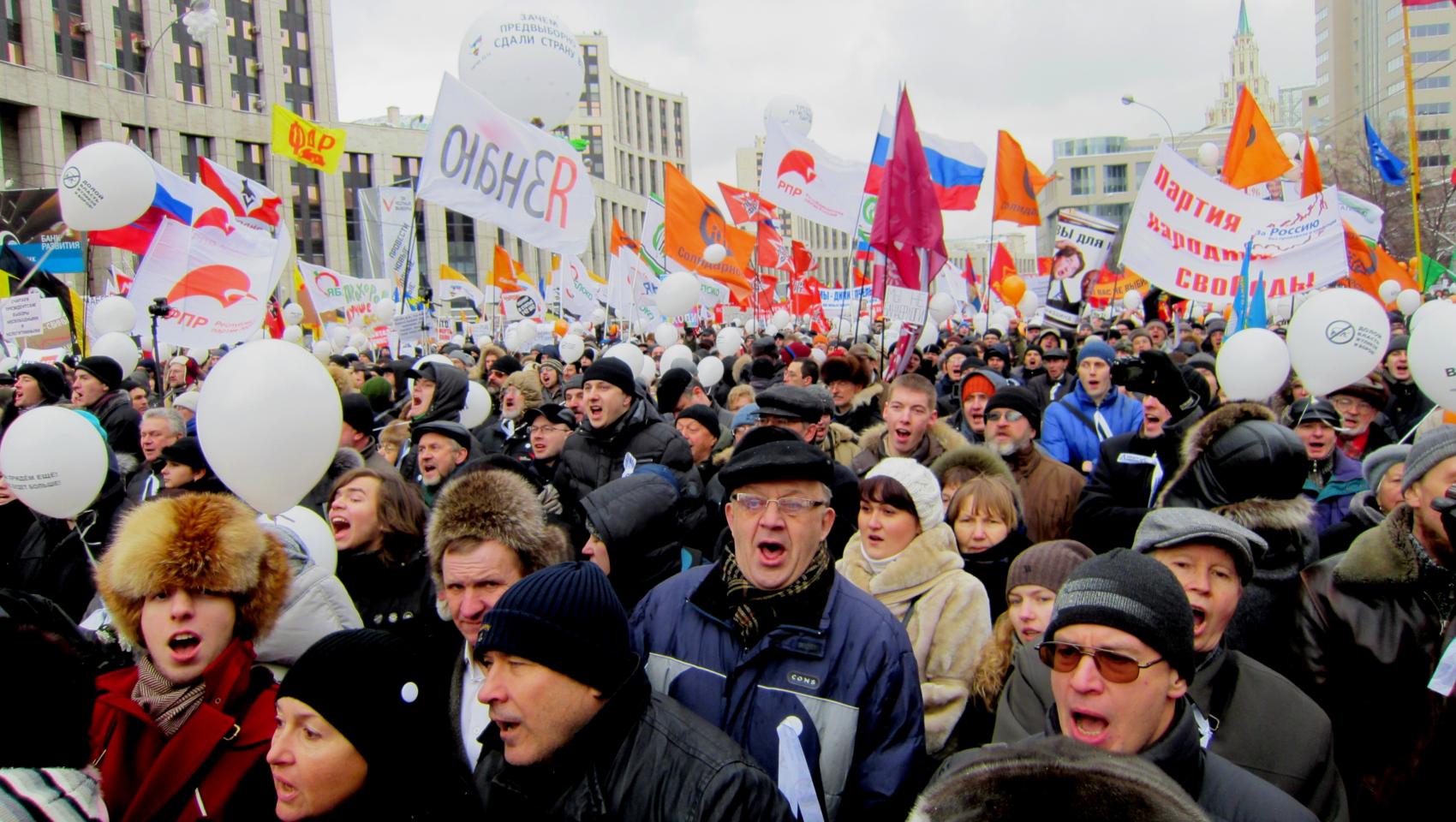
Protest on Bolotnaya Square, Moscow, December 10, 2011.
In 2017, the upper chamber of the Russian parliament launched a specialized commission for the protection of national sovereignty. In its yearly reports, this body repeatedly designated the United States as the most assertive interventionist force, seeking interference in the domestic politics of many states across the globe, including Russia. In advance of this year’s parliamentary elections, Russian President Vladimir Putin warned “about a consistent and very aggressive line” aimed, among other things, at “provoking internal instability, undermining the values that unite Russian society, [to] ultimately weaken Russia and put it under external control.”
The history of international relations provides a long record of actual and presumptive efforts of states to interfere in the affairs of their peers. It also points to the intense backlash of such policies against their initiators. However, even during significant portions of the Cold War, both sides, while suspecting each other of attempts to penetrate their societies, remained relatively confident in the robustness of their political regimes. What then makes foreign interference so bothersome under the current circumstances?
Domestic Fragility as Fuel for Anxiety
The intensity of recent concerns about foreign interference cannot be attributed only to the scale of meddling, which is hard to assess properly anyway. In many instances, governments would benefit from denigrating external influences that portray themselves as being in control. Anxiety over foreign interference harms their image, implying that the government is amenable to subversion. It runs against efforts of the political elites to radiate confidence in their leadership.
Nor does anxiety over foreign interference represent a function of the rise of new communication technologies. Such tools are available not only to external penetrators but also to domestic governments. Illustratively, both Russia and the United States have claimed that the other side outraced it in developing tools to promote its narrative. Moreover, Moscow’s accusations of foreign interference have not so much to do with hacking activities as with Western penetration of organized civil society, media, and national elites.
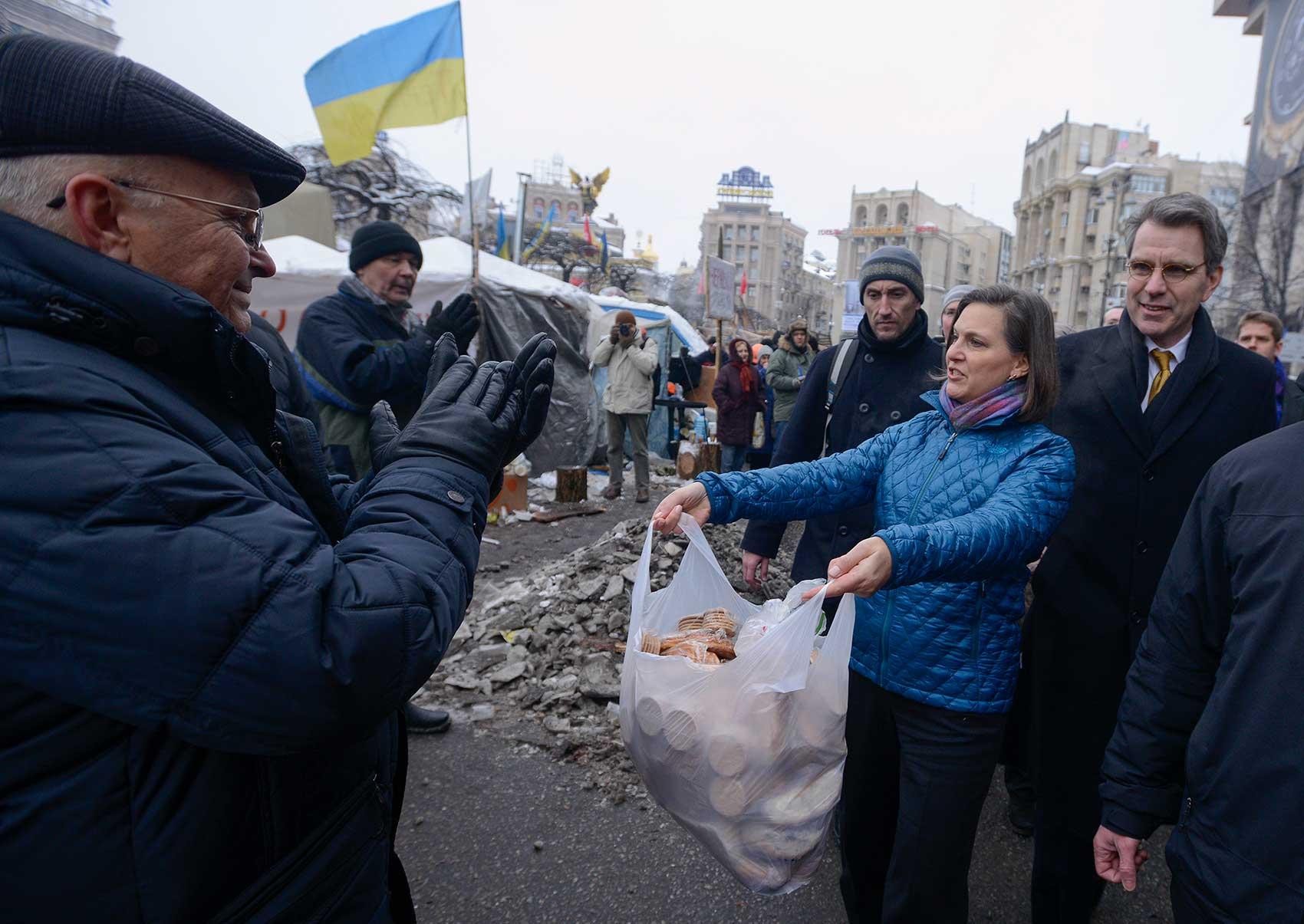
U.S. Assistant Secretary for European and Eurasian Affairs Victoria Nuland offers food to pro-European Union activists as she and U.S. Ambassador to Ukraine Geoffrey Pyatt, right, walk through Independence Square in Kiev, Ukraine, Wednesday, Dec. 11, 2013.
The intensity of current concerns regarding foreign interference reflects a deeper sense of vulnerability of the domestic orders, emerging from broader social processes rather than from technological change or political developments. It inevitably points to the actual areas in which governments feel insecure. While individual countries face multiple difficulties, the one trend observable across the world is the rise of economic inequality. The breadth and depth of this challenge make it the main suspect in explaining the growing sense of vulnerability among national governments.
Both Russia and the United States have faced a drastic rise in economic inequality in recent decades. In Russia, the gap between rich and poor skyrocketed after the collapse of the Soviet Union and reached the level of 1905, right before the first Russian revolution. In the United States, inequality has climbed to a level comparable to that in the late 1920s on the eve of the Great Depression. While direct historical analogies can be distractive, there is little doubt that such trends challenge the internal stability of the two countries.
Income Inequality in Russia
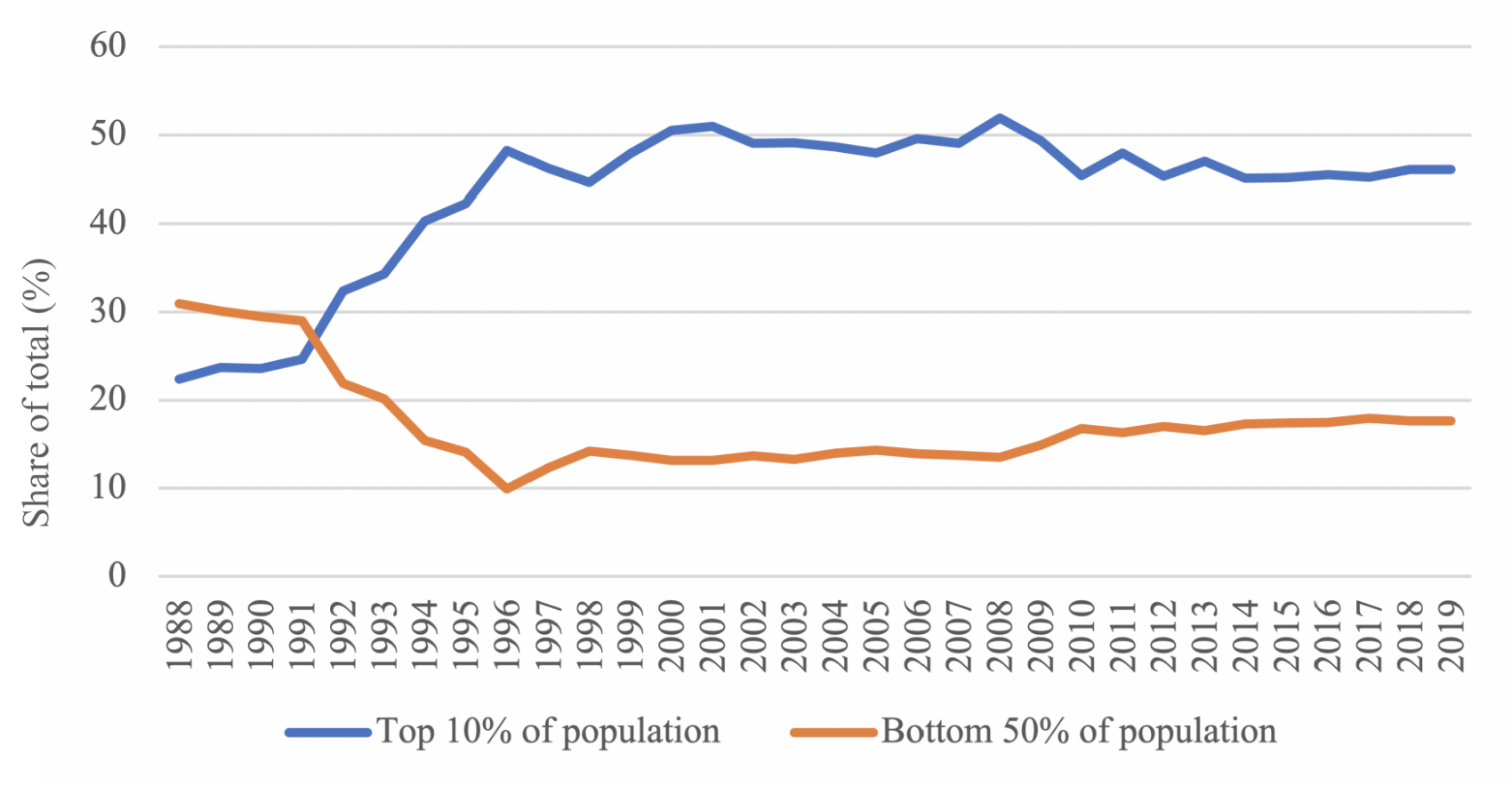
Income Inequality in the United States

Perceived threats make horizontal connections between Russian and American society increasingly toxic politically. Governments increasingly treat such contacts as transmission belts for foreign interference rather than benign channels of communication.
The trend towards greater inequality goes beyond Russia and the United States. The 2020 World Social Report prepared by the UN Department of Economic and Social Affairs argued that between 1990 and 2016, “countries where inequality has grown are home to more than two-thirds (71 per cent) of the world population.” In 2019, the IMF Managing Director Christine Lagarde urged that “inclusive growth is one of the critical challenges of our time.”
The rise of economic inequality proceeded from the globalization of production, the financialization of economies, and the automation of many industries and services. Although the first has slowed down, the other two continue to contribute to the rising gap between haves and have-nots. Unlike previously, economic inequality did not contract even after the Great Recession of 2007–2009 and amid the global pandemic. Throughout history, major economic crises and widespread epidemics, despite all the hardships associated with them, acted as great levelers, but currently, the division between rich and poor stays stable or even increases.
While polls indicate widespread concern over economic inequality, in neither Russia nor the United States does this issue top the list of public misgivings. However, other items on these lists are often closely related to a sense of social injustice. The gap in incomes translates into differences in healthcare and educational opportunities, sensitivity to corruption, and hostility towards immigrants. The chronic nature of inequalities deprives societies of a sense of historical optimism—a hope that current problems will go away with time.
Most Disturbing Problems for Russians, %
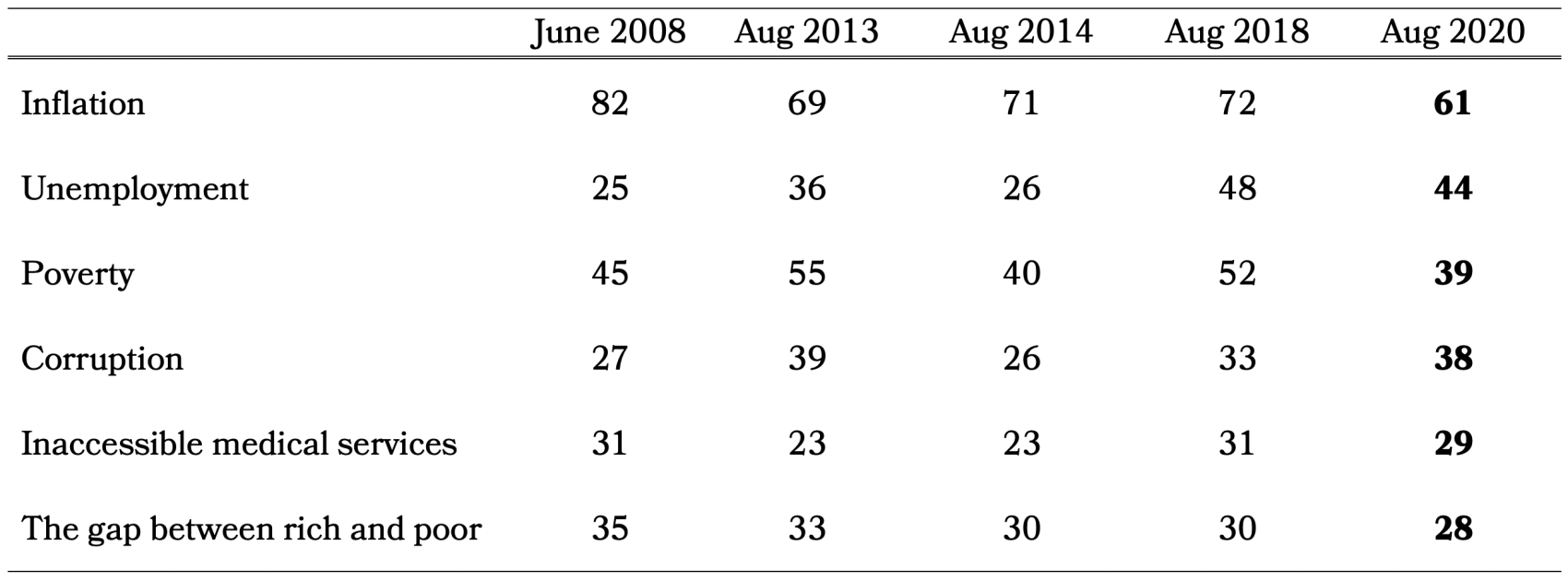
Top Priority Problems for Americans, %

The rise of economic inequality amplifies tensions within societies and fosters political dissatisfaction. It stimulates not only support for wealth redistribution and trade protectionism but also religious, ethnic, and racial divisions, redirecting the blame to the outsiders. Henceforth, it strengthens opposite political movements associated with left-wing socialism and right-wing nationalism. It undermines the moderate center, discrediting the corruption of the ruling political elites and promoting anti-establishment attitudes.
National governments come under mounting pressure and face a looming threat of domestic destabilization. They become increasingly reckless in their attempts to retain internal order and political authority. Turmoil within also has substantial implications for foreign policy, as other states are treated as either part of the solution or part of the problem amid challenges experienced by political elites.
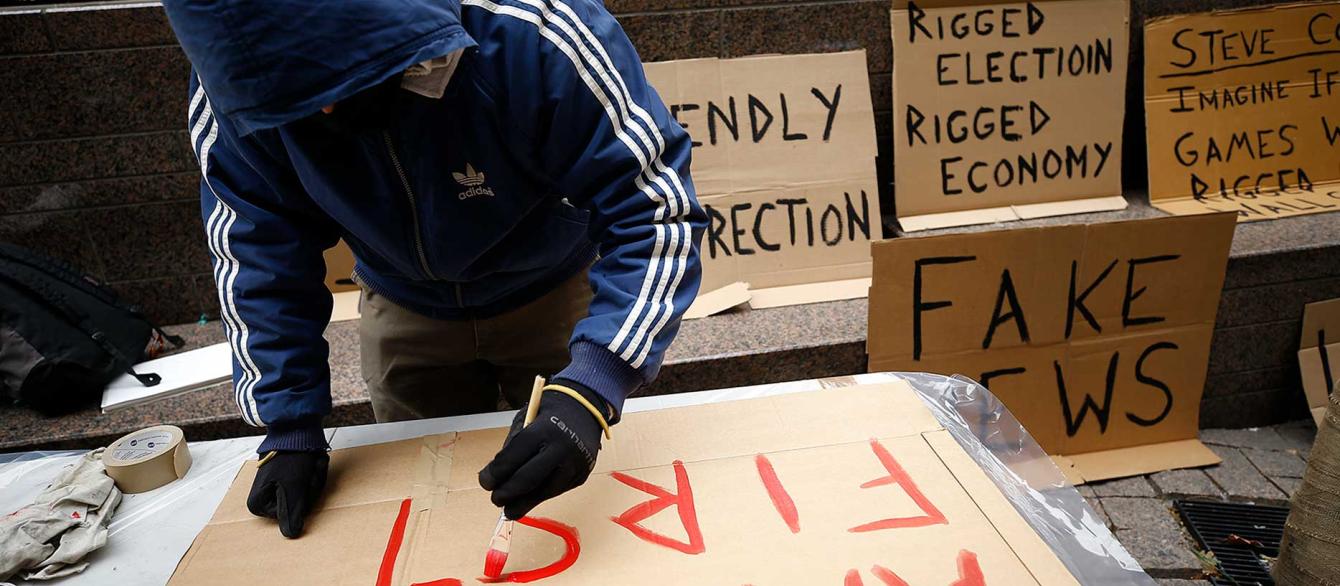
A demonstrator makes an America First placard in Zucotti Park during the Re-Occupy Wall Street demonstration, January 31, 2021.
Political Concerns in the Context of Ideological Divisions
The current social trends, while disturbing, are not entirely without precedent. One could even claim that the period of relative equality in the second half of the twentieth century was something of an exception in comparison to previous epochs. However, at various points throughout history, domestic fragility has produced very different consequences for international politics.
For example, in the nineteenth century, concerns over internal revolutions incentivized great powers to resolve their disputes amicably, contributing to the stability of the Concert of Europe. States, acutely aware of the strains within their societies, avoided international crises that would rock the boat. But such tranquility relied on their ideological homogeneity. The European Concert represented a coalition of dynastical monarchies seeking to tame the republican demands of their peoples.
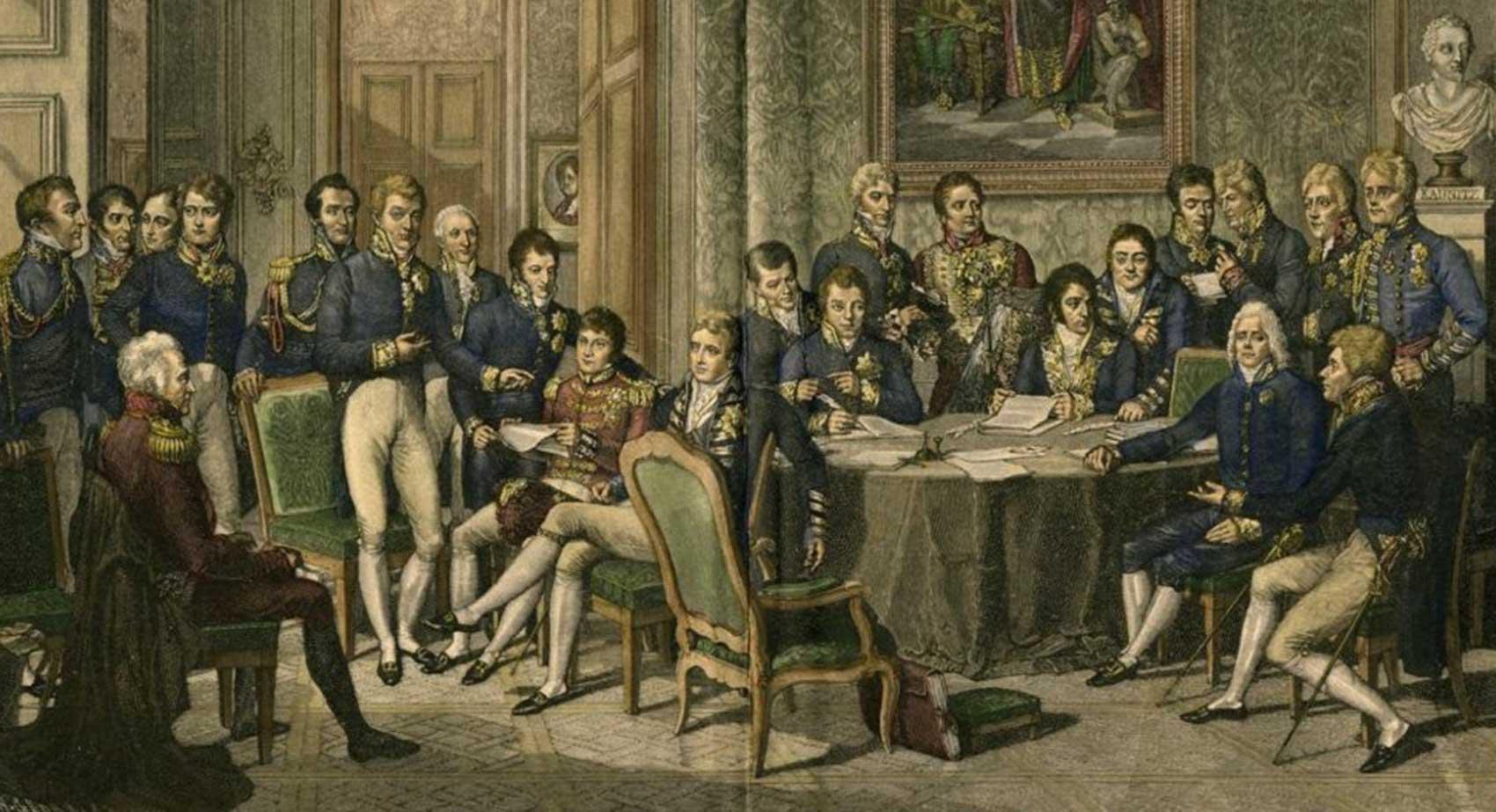
The situation was different when political elites in various states relied on dissimilar ideological justifications for their rule. Growing social dissent caused governments to suspect links between internal opposition and foreign adversaries. This logic operated in the 1930s, when concerns over external meddling in domestic politics added to the traditional threats regarding territorial integrity. However, such tensions were somewhat ameliorated by the ideological multipolarity of that period. Multiple contradictions between Fascist, Liberal, and Marxist regimes caused political elites to see states with different ideologies not only as dangerous opponents but also as potential partners.
The current ideological environment is much less nuanced. A growing tendency, especially prevalent across the West, assumes an insurmountable divide between just two types of political regimes, and labels states as either autocratic or democratic. This sharp division amplifies hostility, making attempts to overcome emerging suspicions especially problematic. Domestic fragility under ideological bipolarity causes a passionate search for a “fifth column” within countries and intense concerns over foreign interference.

Russian President Vladimir Putin met with his Security Council on April 16, 2021, to discuss responses to U.S. sanctions against Russia announced the day before.
For political elites, these anxieties transform international rivalries into an existential struggle. They make any hints of external meddling especially dangerous, contributing to spirals of escalation. They close pathways for potential détente unless governments can be reassured of the stability of their domestic authority. The current Russia-U.S. tensions suffer from such logic. Both preconditions for intense threat perceptions surrounding foreign interference are present. Moscow and Washington experience domestic vulnerability due to growing economic inequality and find each other on opposite sides of the ideological divide.
Under these circumstances, the prospects for managing threat perceptions look dim. Any new information filters through the lens of preexisting anxiety as implicating evidence. Suspicions of the other side become self-reinforcing. Concerns over foreign interference seem unlikely to dissipate, even if the population tires of media debates over the external threat to national elections.
Moreover, these perceived threats make horizontal connections between Russian and American society increasingly toxic politically. Governments increasingly treat such contacts as transmission belts for foreign interference rather than benign channels of communication. This perspective is unfortunate, as such ties in other circumstances often play an essential role as testing grounds for potential rapprochement.
In previous years, Russian and American experts floated several initiatives to normalize relations or at least prevent the most dangerous consequences of ongoing tensions. Recently a large group of specialists from across the Euro-Atlantic region shared a package of ideas on military risk reduction. One can only hope that such measures, which have nothing to do with domestic politics, will get through—despite the anxiety over foreign interference.
This piece develops ideas presented at the roundtable “Re-building Russian-American Relations: Challenges and Possibilities” during the 2021 International Studies Association Convention. The author thanks all of the organizers and participants of this event.




